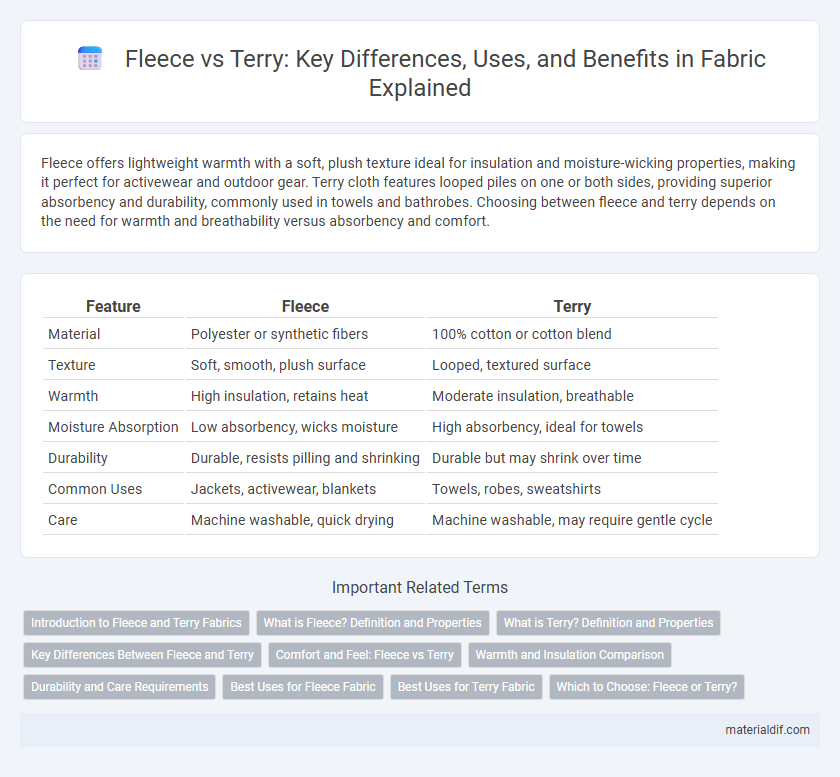Fleece offers lightweight warmth with a soft, plush texture ideal for insulation and moisture-wicking properties, making it perfect for activewear and outdoor gear. Terry cloth features looped piles on one or both sides, providing superior absorbency and durability, commonly used in towels and bathrobes. Choosing between fleece and terry depends on the need for warmth and breathability versus absorbency and comfort.
Table of Comparison
| Feature | Fleece | Terry |
|---|---|---|
| Material | Polyester or synthetic fibers | 100% cotton or cotton blend |
| Texture | Soft, smooth, plush surface | Looped, textured surface |
| Warmth | High insulation, retains heat | Moderate insulation, breathable |
| Moisture Absorption | Low absorbency, wicks moisture | High absorbency, ideal for towels |
| Durability | Durable, resists pilling and shrinking | Durable but may shrink over time |
| Common Uses | Jackets, activewear, blankets | Towels, robes, sweatshirts |
| Care | Machine washable, quick drying | Machine washable, may require gentle cycle |
Introduction to Fleece and Terry Fabrics
Fleece is a soft, warm fabric made from synthetic fibers such as polyester, known for its insulating properties and lightweight feel. Terry fabric, commonly made from cotton or cotton blends, features uncut loops on one or both sides, providing high absorbency and a textured surface ideal for towels and bathrobes. Both fabrics serve distinct purposes, with fleece excelling in warmth and moisture-wicking, while terry prioritizes absorbency and durability.
What is Fleece? Definition and Properties
Fleece is a soft, insulating fabric made from synthetic fibers like polyester, designed to provide warmth and comfort while being lightweight. Known for its moisture-wicking properties and quick-drying ability, fleece is highly breathable and resistant to shrinking, making it ideal for outdoor and activewear. Its plush texture and thermal insulation make it a popular choice for jackets, blankets, and cold-weather apparel.
What is Terry? Definition and Properties
Terry fabric is a type of woven textile characterized by its looped pile on one or both sides, made primarily from cotton or cotton blends, which enhances absorbency and softness. Its unique construction involves uncut loops of yarn, giving it a textured surface ideal for towels, bathrobes, and sportswear due to its excellent moisture-wicking properties. Terry's durability and breathability make it a popular choice for fabrics requiring both comfort and high performance in moisture management.
Key Differences Between Fleece and Terry
Fleece is a synthetic fabric made primarily from polyester, known for its lightweight insulation and moisture-wicking properties, making it ideal for activewear and cold-weather gear. Terry cloth, typically made from cotton or a cotton blend, features looped pile fabric that excels in absorbency, commonly used in towels and bathrobes. Key differences include fleece's smooth, soft surface that traps heat versus terry's textured loops designed to absorb water efficiently.
Comfort and Feel: Fleece vs Terry
Fleece offers a soft, plush texture with excellent insulation, making it ideal for warmth and cozy comfort in colder conditions. Terry fabric features looped piles that provide a slightly rougher feel, enhancing absorbency and breathability, which is perfect for towels and loungewear. When prioritizing comfort, fleece excels in softness and heat retention, while terry is favored for its moisture-wicking properties and durability against wear.
Warmth and Insulation Comparison
Fleece fabric offers superior warmth and insulation due to its synthetic fibers that trap heat efficiently, making it ideal for cold weather clothing. Terry cloth, composed of cotton loops, provides moderate insulation with excellent moisture absorption but lacks fleece's heat retention capabilities. For maximum warmth in outdoor activities, fleece is preferred over terry because of its lightweight and high thermal efficiency.
Durability and Care Requirements
Fleece fabric offers high durability due to its synthetic fibers, which resist pilling and maintain softness after multiple washes, making it ideal for activewear and outdoor gear. Terry cloth, made from cotton loops, provides excellent absorbency but requires gentle care to prevent fraying and maintain loop integrity, often needing lower wash temperatures and air drying. Both fabrics demand different maintenance approaches: fleece benefits from machine washing on gentle cycles, while terry thrives with less abrasive handling to maximize longevity.
Best Uses for Fleece Fabric
Fleece fabric excels in insulation and moisture-wicking, making it ideal for cold-weather clothing like jackets, sweaters, and activewear. Its soft, lightweight texture provides warmth without bulk, perfect for outdoor gear and cozy loungewear. Fleece is also favored for blankets and linings due to its quick-drying and breathable properties.
Best Uses for Terry Fabric
Terry fabric, known for its looped pile surface, excels in absorbency and durability, making it ideal for towels, bathrobes, and sportswear. Its textured weave enhances moisture retention while providing softness and comfort, suitable for activewear and casual clothing. Terry's robustness and breathability also make it a popular choice for baby products and home textiles like washcloths and bath mats.
Which to Choose: Fleece or Terry?
Fleece offers superior warmth and softness, making it ideal for cold-weather clothing and cozy blankets, while terry fabric provides excellent moisture absorption and breathability, perfect for towels and activewear. Choosing fleece suits those seeking insulation and comfort, whereas terry is better for items requiring quick drying and durability. Consider the intended use and climate to determine whether fleece's plush texture or terry's absorbent loops best meet your needs.
Fleece vs Terry Infographic

 materialdif.com
materialdif.com